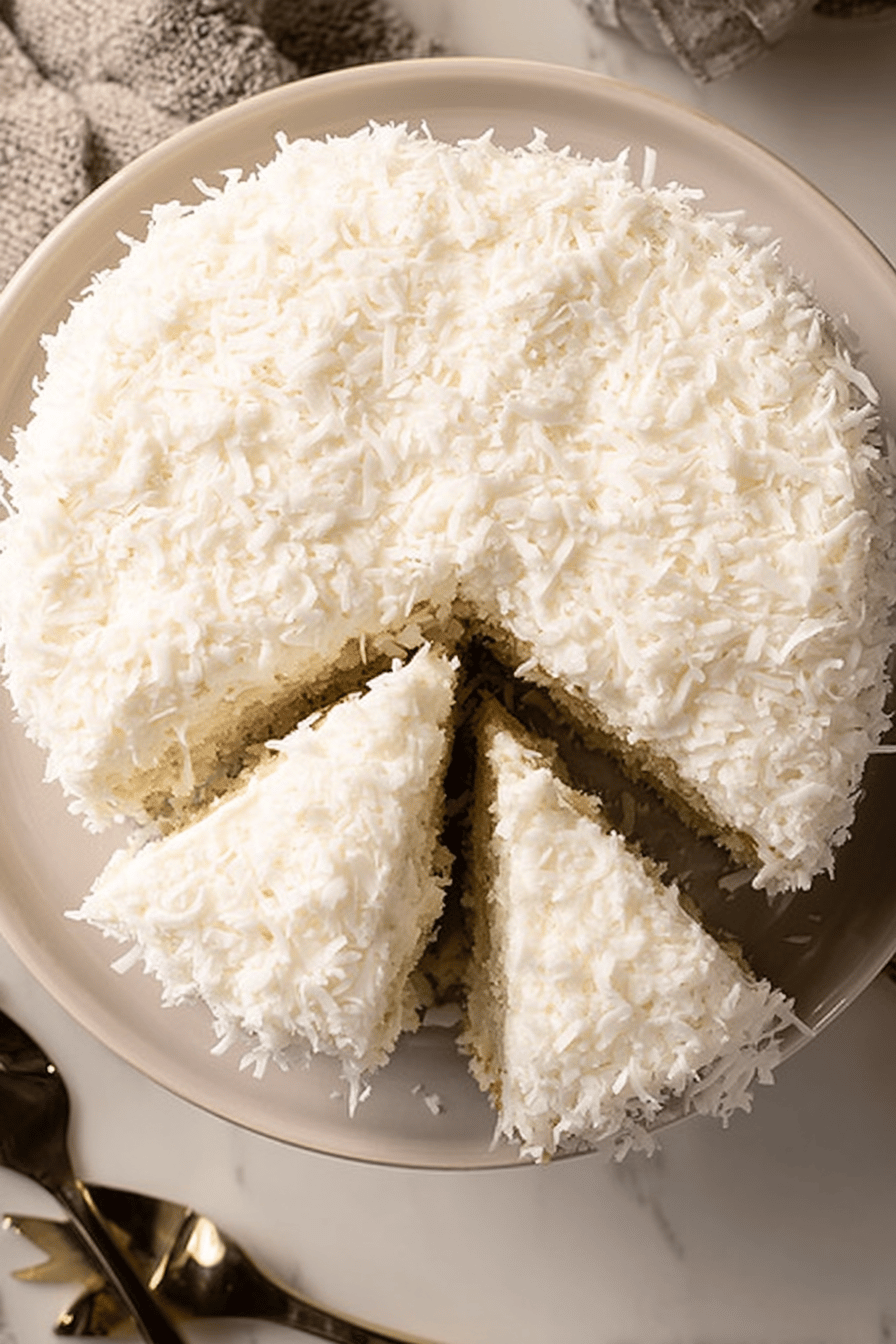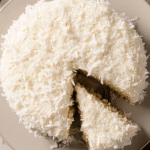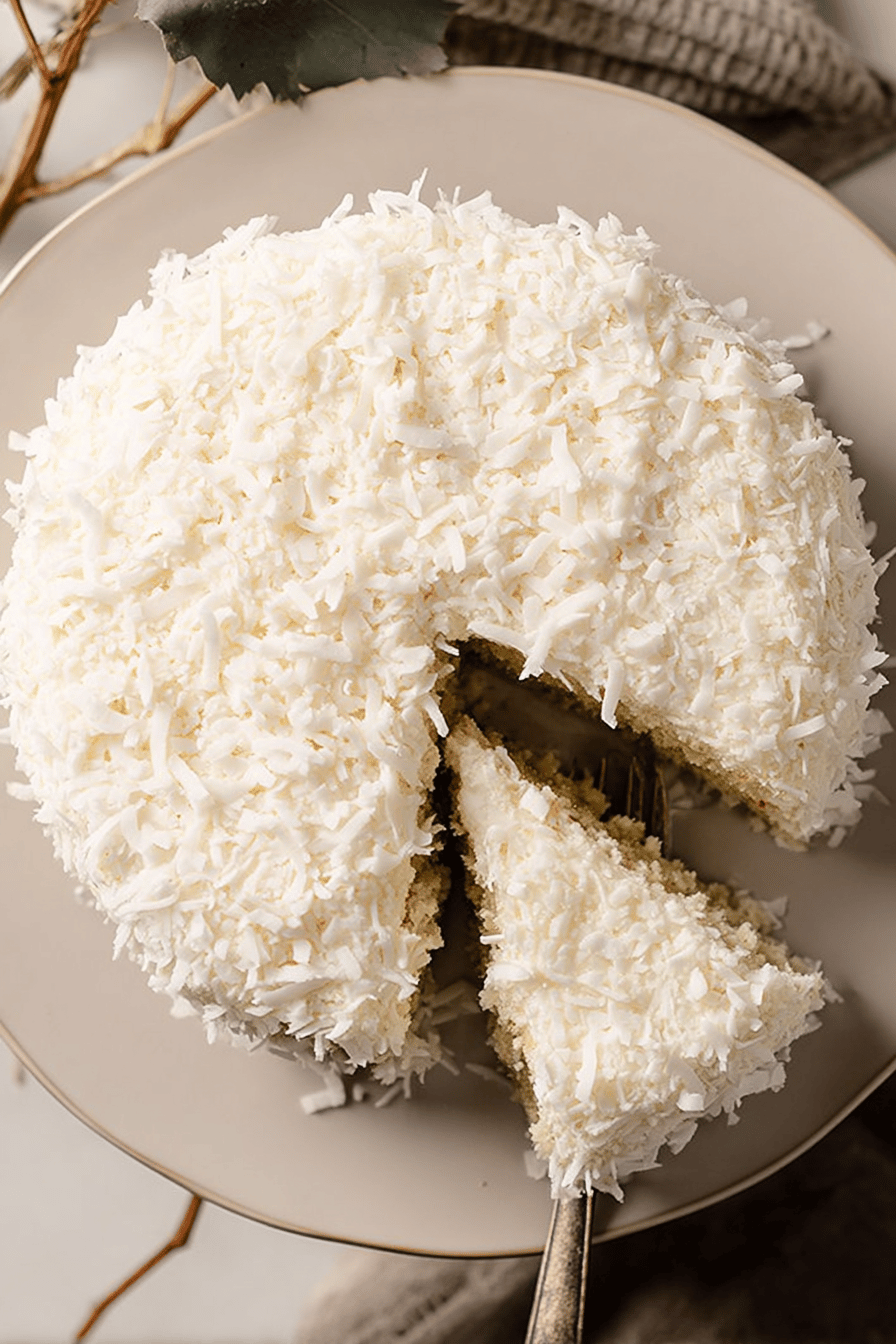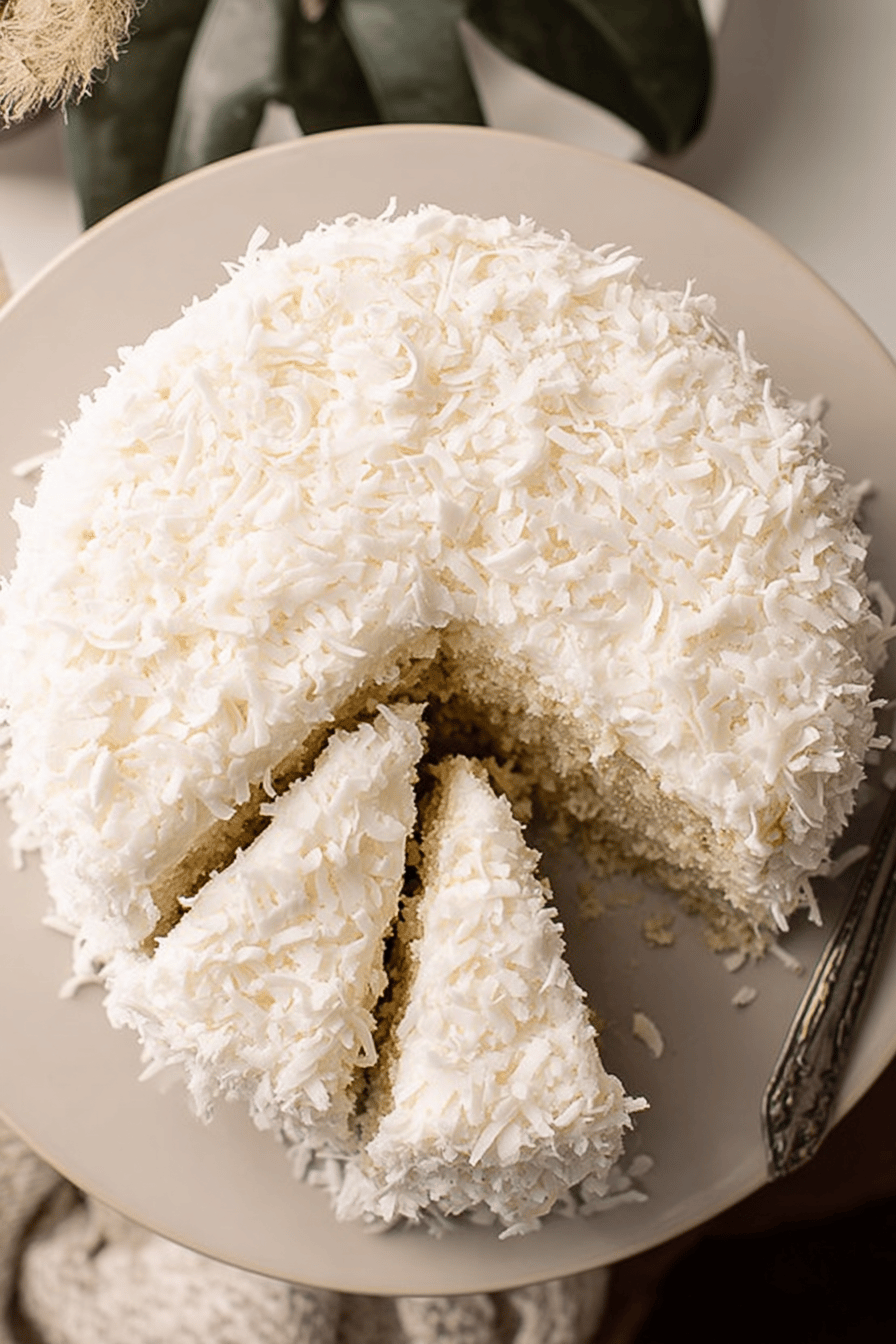Why You’ll Love This Homemade Coconut Cake
Imagine pulling a freshly baked homemade coconut cake out of the oven, its layers moist and full of tropical flavor that makes every bite feel like a vacation. This recipe stands out for its simple steps that even beginners can follow without stress, turning kitchen time into a fun adventure. You’ll appreciate how it brings people together at family gatherings, offering a treat that’s both satisfying and easy to make.
One of the best parts is the health perks from ingredients like coconut, which offer healthy fats and a boost of vitamins to keep things nutritious. Whether you’re baking for a quick weeknight dessert or a special celebration, this cake adapts to what you have on hand. Plus, its creamy frosting adds a luxurious touch that elevates the experience without much effort.
Key Features of the Recipe
- It comes together quickly, often in under an hour of active prep.
- The natural sweetness from coconut makes it lighter than many desserts.
- You can tweak it for different tastes or needs, like adding fruits for extra flair.
Many home bakers find this recipe becomes a go-to choice because it delivers reliable results every time. Let’s dive into what makes the ingredients so special next. For more ideas on fruity cakes, check out our pineapple coconut dream cake that pairs perfectly with this one.
Jump To
- 1. Why You’ll Love This Homemade Coconut Cake
- 2. Essential Ingredients for Homemade Coconut Cake
- 3. How to Prepare the Perfect Homemade Coconut Cake: Step-by-Step Guide
- 4. Dietary Substitutions to Customize Your Homemade Coconut Cake
- 5. Mastering Homemade Coconut Cake: Advanced Tips and Variations
- 6. How to Store Homemade Coconut Cake: Best Practices
- 7. FAQs: Frequently Asked Questions About Homemade Coconut Cake
- 8. Homemade Coconut Cake
Essential Ingredients for Homemade Coconut Cake
Gathering the right ingredients is the first step to creating a delicious homemade coconut cake that turns out perfectly every time. This recipe focuses on fresh, simple items that enhance the cake’s moist texture and tropical taste. Below, you’ll find a complete list for both the cake and the frosting, making it easy to shop and prepare.
Cake Ingredients
Here is the full list of ingredients needed for the cake. Each one plays a key role in building flavor and structure.
- 2 and 1/2 cups cake flour
- 2 teaspoons baking powder
- 1/2 teaspoon baking soda
- 1 teaspoon salt
- 3/4 cup unsalted butter at room temperature
- 1 and 2/3 cups granulated sugar
- 5 large egg whites at room temperature
- 1/2 cup sour cream at room temperature
- 2 teaspoons pure vanilla extract
- 1 teaspoon coconut extract
- 1 cup unsweetened canned coconut milk at room temperature
- 1 cup sweetened shredded coconut
Frosting Ingredients
For the coconut cream cheese buttercream frosting, use these items to create a smooth, creamy topping.
- 1 cup unsalted butter at room temperature
- 8 ounces full-fat cream cheese softened to room temperature
- 5 cups confectioners sugar
- 2 tablespoons canned coconut milk
- 1/2 teaspoon pure vanilla extract
- 1/2 teaspoon coconut extract
- 1/8 teaspoon salt
- 2 cups sweetened shredded coconut
These ingredients ensure your homemade coconut cake has the perfect balance of flavors and textures. If you’re looking for more baking inspiration, try our crustless coconut pie for a simpler twist on coconut desserts.
How to Prepare the Perfect Homemade Coconut Cake: Step-by-Step Guide
Getting started with this homemade coconut cake is straightforward and fun, beginning with prepping your kitchen. First, preheat your oven to 350°F (175°C) and grease your cake pans to avoid any sticking issues. This sets the stage for a smooth baking process that leads to moist layers.
Next, in a large bowl, mix the dry ingredients including the cake flour, baking powder, baking soda, and salt until they blend evenly. In another bowl, cream the unsalted butter and granulated sugar until light and fluffy, which helps create that airy texture. Then, add the egg whites one at a time, followed by the sour cream, vanilla extract, and coconut extract for a burst of flavor.
Once the wet ingredients are well combined, slowly incorporate the dry mix along with the unsweetened canned coconut milk, stirring gently to keep the batter smooth. Fold in the sweetened shredded coconut for added texture, then pour the batter into your prepared pans. Bake for 25-30 minutes, checking with a toothpick to ensure it’s done without overcooking.
Tips for Baking Success
- Use room temperature ingredients to help everything mix better and rise properly.
- If adapting for dietary needs, swap in alternatives at this stage for a seamless change.
- Let the cakes cool fully before adding frosting to prevent it from melting.
This method results in layers that are incredibly moist and full of coconut goodness. After baking, you’ll move on to frosting, which brings everything together beautifully.
Dietary Substitutions to Customize Your Homemade Coconut Cake
Making this homemade coconut cake work for your lifestyle is simple with a few smart swaps. Start by considering options for protein and main components to fit various needs. For instance, flax or chia eggs can replace the egg whites if you’re going vegan, keeping the cake just as fluffy.
Protein and Main Component Alternatives
Almond flour or coconut flour makes a great substitute for cake flour in gluten-free versions, though you might need to adjust the liquid slightly for the right consistency. This ensures the cake stays moist and delicious without wheat.
Vegetable, Sauce, and Seasoning Modifications
Try mixing in vanilla or almond extracts to boost the flavor in a subtle way. For a lighter twist, use fruit purees instead of full-fat frosting, or add spices like cinnamon to change things up for different seasons. These changes let everyone enjoy the cake their way.
| Original Ingredient | Substitution Option | Benefits |
|---|---|---|
| Egg whites | Flax eggs | Vegan-friendly and adds omega-3s |
| Cake flour | Almond flour | Gluten-free and nutty flavor |
| Granulated sugar | Stevia | Lower calorie option |
These adjustments keep the homemade coconut cake versatile and inclusive.
Mastering Homemade Coconut Cake: Advanced Tips and Variations
Once you’re comfortable with the basic recipe, try some advanced techniques to take your homemade coconut cake to the next level. Gently fold the shredded coconut into the batter to preserve its fluffiness and create even distribution. Using room temperature ingredients ensures everything blends smoothly, leading to a better rise and texture.
Flavor Variations
Add lime zest or toasted coconut flakes for a fresh twist that enhances the tropical vibe. If you’re feeling creative, incorporate other fruits like pineapple to mix things up. Presentation is key, so top your cake with fresh shreds and perhaps some edible flowers for a stunning look.
Make-Ahead Ideas
Prepare the batter in advance and store it in the fridge, or bake the layers ahead and freeze them for busy days. This approach saves time while keeping the quality high, making it ideal for planning events. With these tips, your homemade coconut cake will become a signature dish.
How to Store Homemade Coconut Cake: Best Practices
Proper storage keeps your homemade coconut cake tasting fresh and moist for longer. Keep it in an airtight container in the fridge, where it stays good for 3-4 days. This method helps maintain the frosting’s creamy texture without it getting too hard.
For longer term, wrap the cake tightly in plastic wrap and then foil before popping it in the freezer; it can last up to 2 months this way. When you’re ready to eat, thaw it overnight in the fridge and warm it briefly in a low oven to bring back that soft feel. Portioning slices before freezing makes it easy to grab just what you need.

FAQs: Frequently Asked Questions About Homemade Coconut Cake
How do I make a moist homemade coconut cake?
To make a moist homemade coconut cake, start by using ingredients like buttermilk or sour cream, which add moisture and richness. Use unsweetened shredded coconut in the batter for extra texture. Avoid overbaking by checking the cake 5-10 minutes before the recommended time; insert a toothpick in the center and bake until it comes out clean. Finally, brushing the cake layers with a simple syrup made from sugar and water infused with coconut extract before frosting helps lock in moisture.
What is the best frosting for a coconut cake?
Cream cheese frosting and coconut buttercream are popular choices for coconut cake because their creamy texture complements the cake’s flavor. To make a coconut buttercream, combine butter, powdered sugar, and coconut milk or cream. Adding shredded coconut on top enhances texture and appearance. Ensure the frosting is not overly sweet to balance the natural sweetness of the coconut cake.
Can I use coconut milk instead of regular milk in the cake recipe?
Yes, coconut milk can be used instead of regular milk to enhance the cake’s coconut flavor and richness. Use the same quantity called for in the recipe. Full-fat coconut milk provides the best texture and moisture. Be sure to shake the can well before measuring, as the cream may separate. This substitution is especially beneficial for those seeking a dairy-free option with an authentic coconut taste.
How should I store homemade coconut cake to keep it fresh?
Homemade coconut cake should be stored in an airtight container to prevent it from drying out. If frosted, keeping it in the refrigerator is recommended because of the cream cheese or buttercream frosting. Before serving, allow the cake to reach room temperature for the best flavor and texture. For longer storage, wrap the cake tightly in plastic wrap and freeze it for up to 2 months; thaw in the refrigerator overnight before serving.
How can I make my homemade coconut cake allergy-friendly?
To make a coconut cake allergy-friendly, substitute wheat flour with gluten-free flour blends, and replace dairy butter and milk with plant-based alternatives like vegan butter and coconut or almond milk. Use egg replacers such as applesauce or flaxseed meal mixed with water. Be sure to confirm all ingredients, including shredded coconut, are processed in allergy-safe facilities. This way, you can create a delicious coconut cake suitable for common allergies without sacrificing taste.

Homemade Coconut Cake
- Total Time: 50 minutes
- Yield: 12 servings
- Diet: Vegetarian
Description
🥥 Savor a tropical delight with moist coconut cake layers rich in flavor and texture.
🍰 Topped with creamy coconut cream cheese frosting, this cake is a perfect treat for any occasion.
Ingredients
– 2 and 1/2 cups cake flour
– 2 teaspoons baking powder
– 1/2 teaspoon baking soda
– 1 teaspoon salt
– 3/4 cup unsalted butter at room temperature
– 1 and 2/3 cups granulated sugar
– 5 large egg whites at room temperature
– 1/2 cup sour cream at room temperature
– 2 teaspoons pure vanilla extract
– 1 teaspoon coconut extract
– 1 cup unsweetened canned coconut milk at room temperature
– 1 cup sweetened shredded coconut
– 1 cup unsalted butter at room temperature
– 8 ounces full-fat cream cheese softened to room temperature
– 5 cups confectioners sugar
– 2 tablespoons canned coconut milk
– 1/2 teaspoon pure vanilla extract
– 1/2 teaspoon coconut extract
– 1/8 teaspoon salt
– 2 cups sweetened shredded coconut
Instructions
1-Getting started with this homemade coconut cake: First, preheat your oven to 350°F (175°C) and grease your cake pans to avoid any sticking issues. This sets the stage for a smooth baking process that leads to moist layers.
2-Mixing dry and wet ingredients: In a large bowl, mix the dry ingredients including the cake flour, baking powder, baking soda, and salt until they blend evenly. In another bowl, cream the unsalted butter and granulated sugar until light and fluffy, which helps create that airy texture. Then, add the egg whites one at a time, followed by the sour cream, vanilla extract, and coconut extract for a burst of flavor.
3-Combining and baking the batter: Once the wet ingredients are well combined, slowly incorporate the dry mix along with the unsweetened canned coconut milk, stirring gently to keep the batter smooth. Fold in the sweetened shredded coconut for added texture, then pour the batter into your prepared pans. Bake for 25-30 minutes, checking with a toothpick to ensure it’s done without overcooking.
Notes
🥥 Use room temperature ingredients to achieve a smooth, even batter.
🍰 Avoid overmixing to keep the cake moist and tender.
❄️ Chill the frosting briefly if it becomes too soft to work with.
- Prep Time: 20 minutes
- Cook Time: 30 minutes
- Category: Dessert
- Method: Baking
- Cuisine: American
Nutrition
- Serving Size: 1 slice
- Calories: 450
- Sugar: 38g
- Sodium: 220mg
- Fat: 25g
- Saturated Fat: 15g
- Carbohydrates: 50g
- Fiber: 1g
- Protein: 5g
- Cholesterol: 80mg
Keywords: Coconut Cake, Moist Cake, Creamy Frosting, Coconut Dessert


